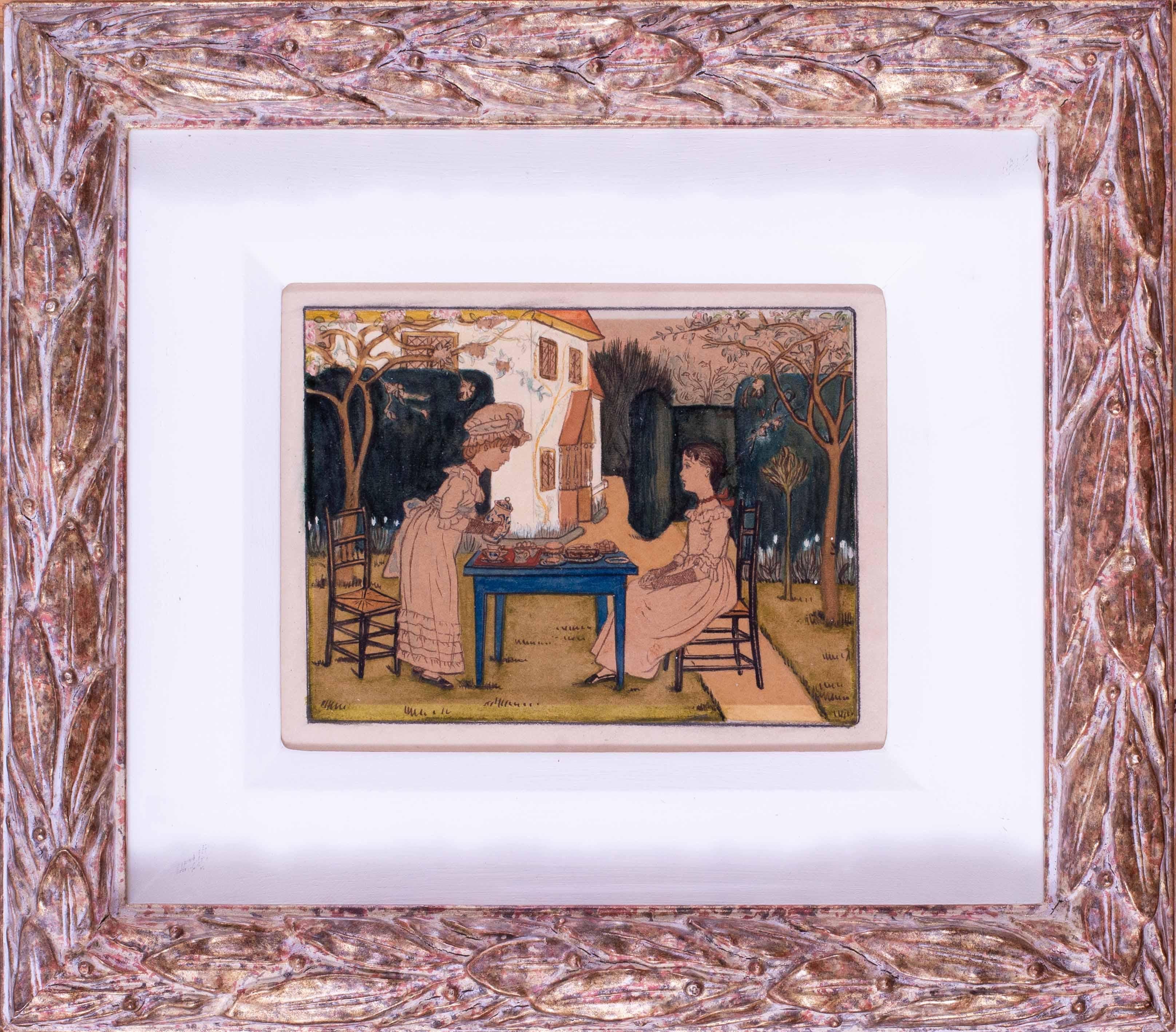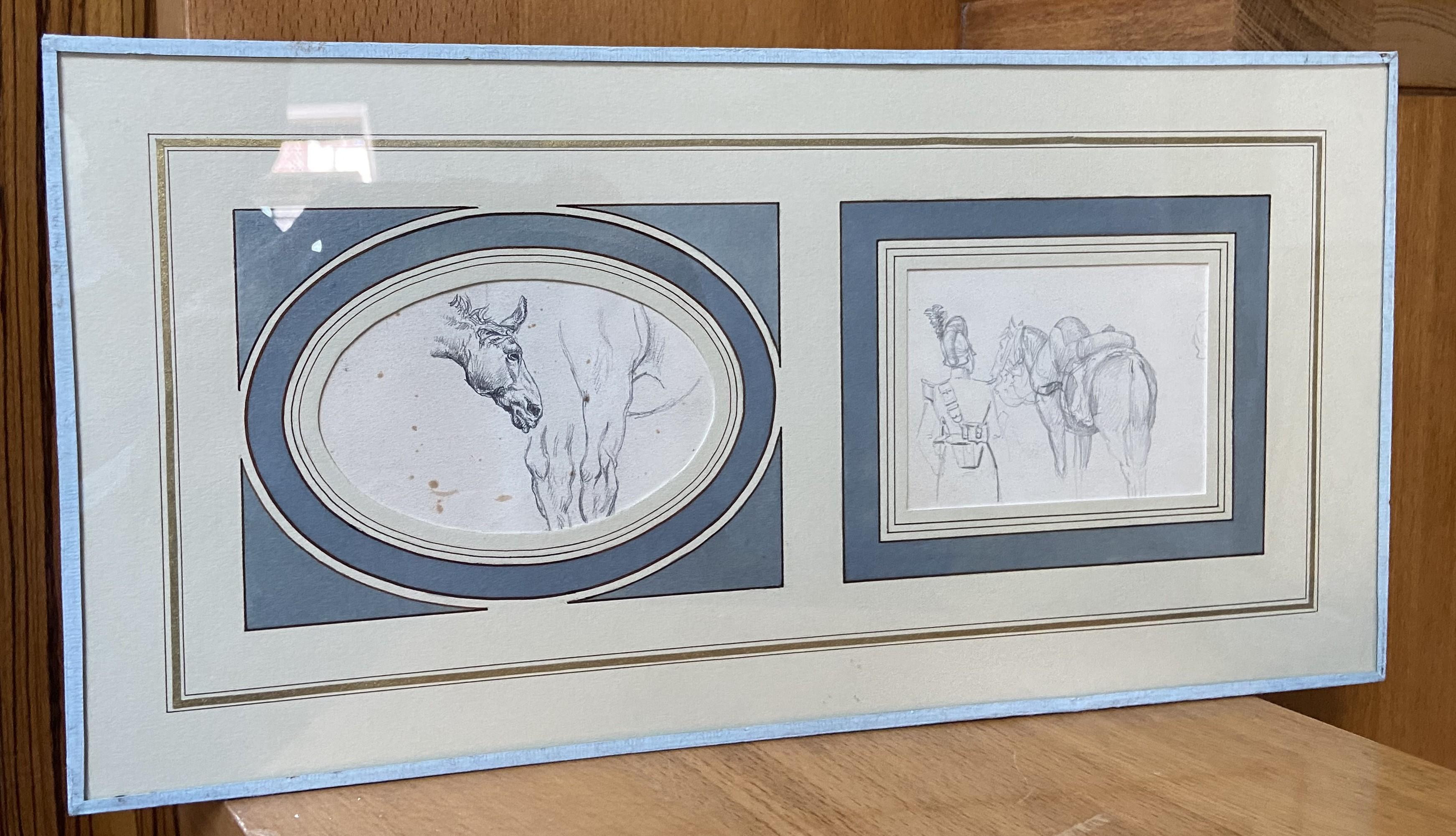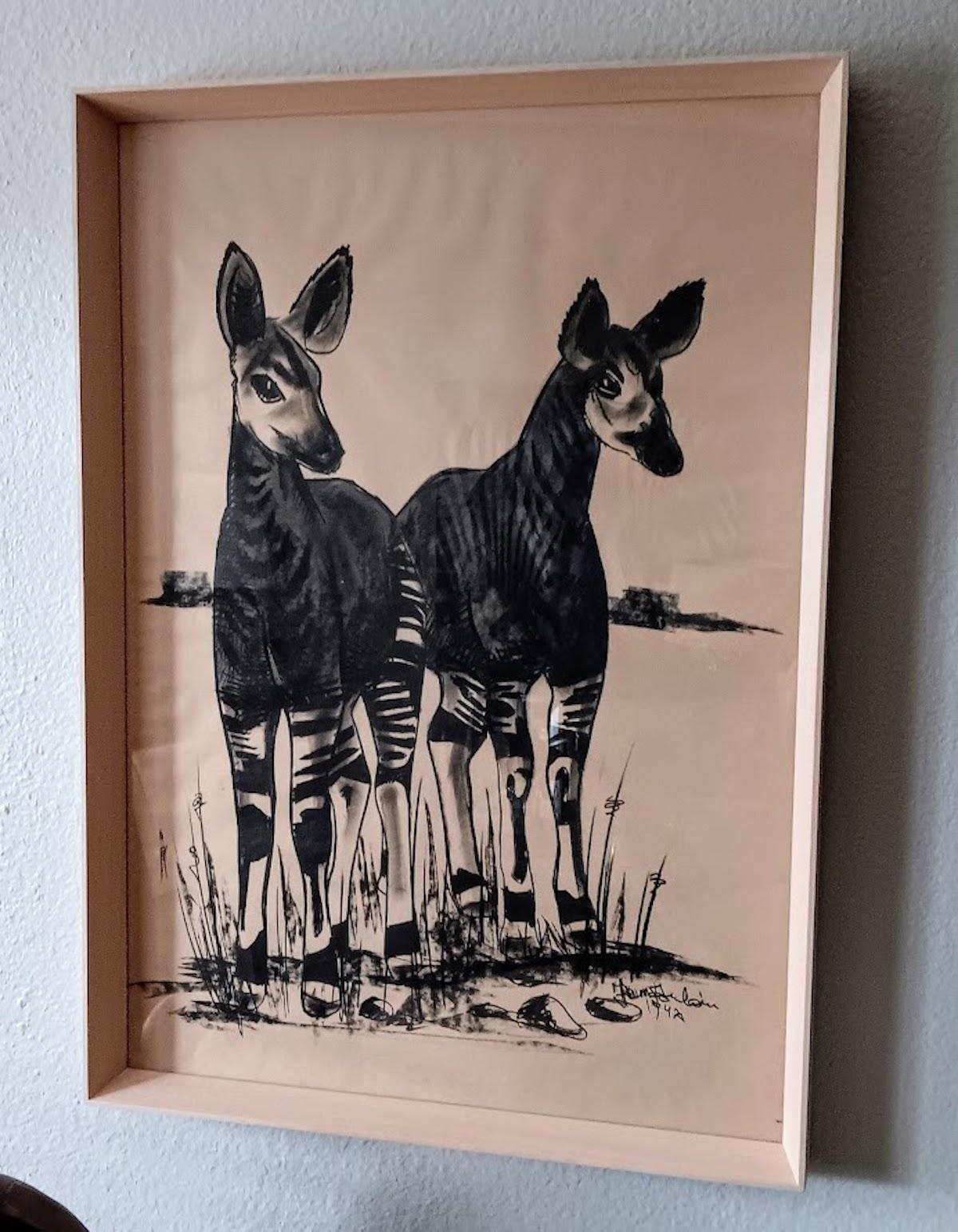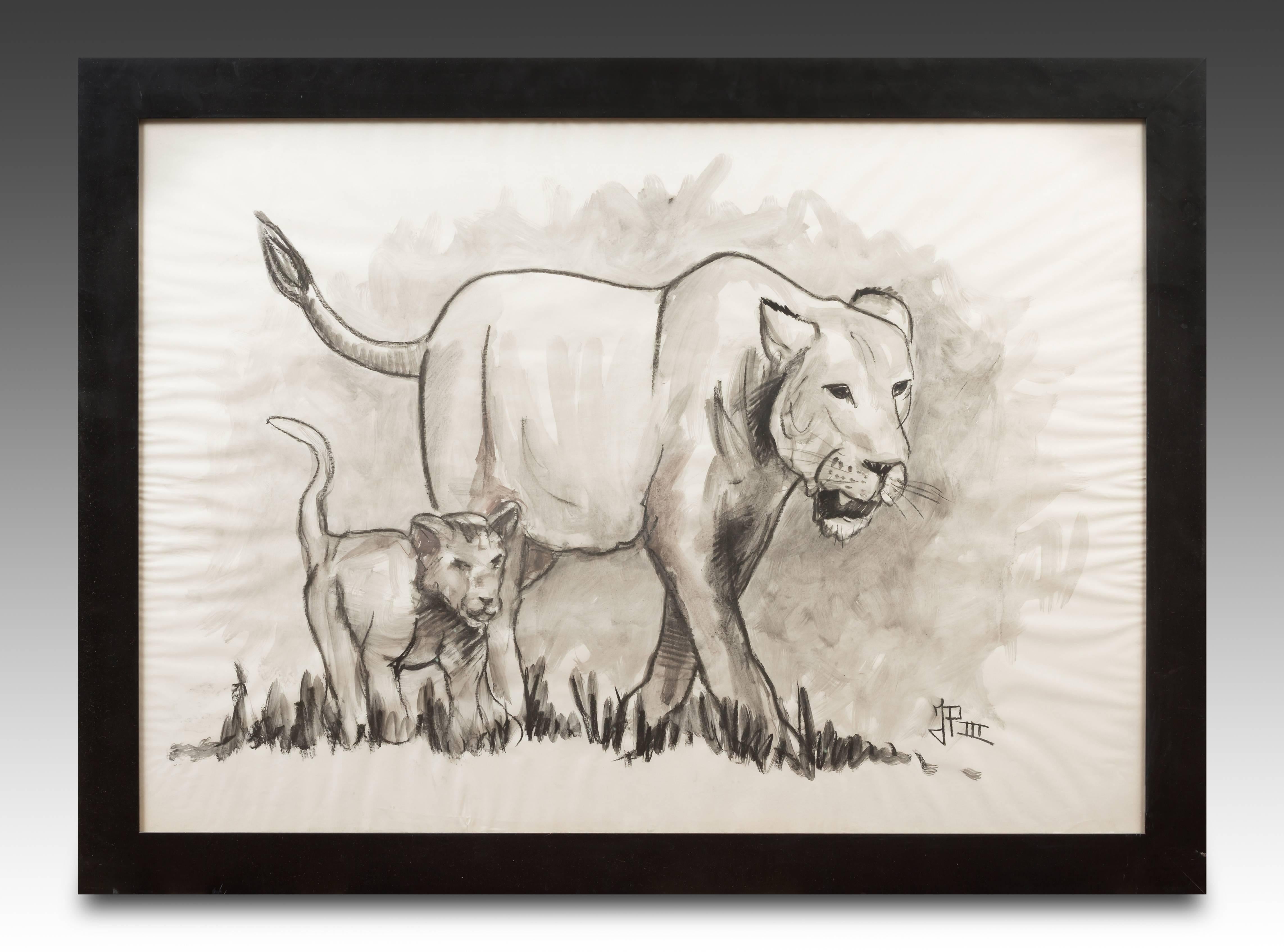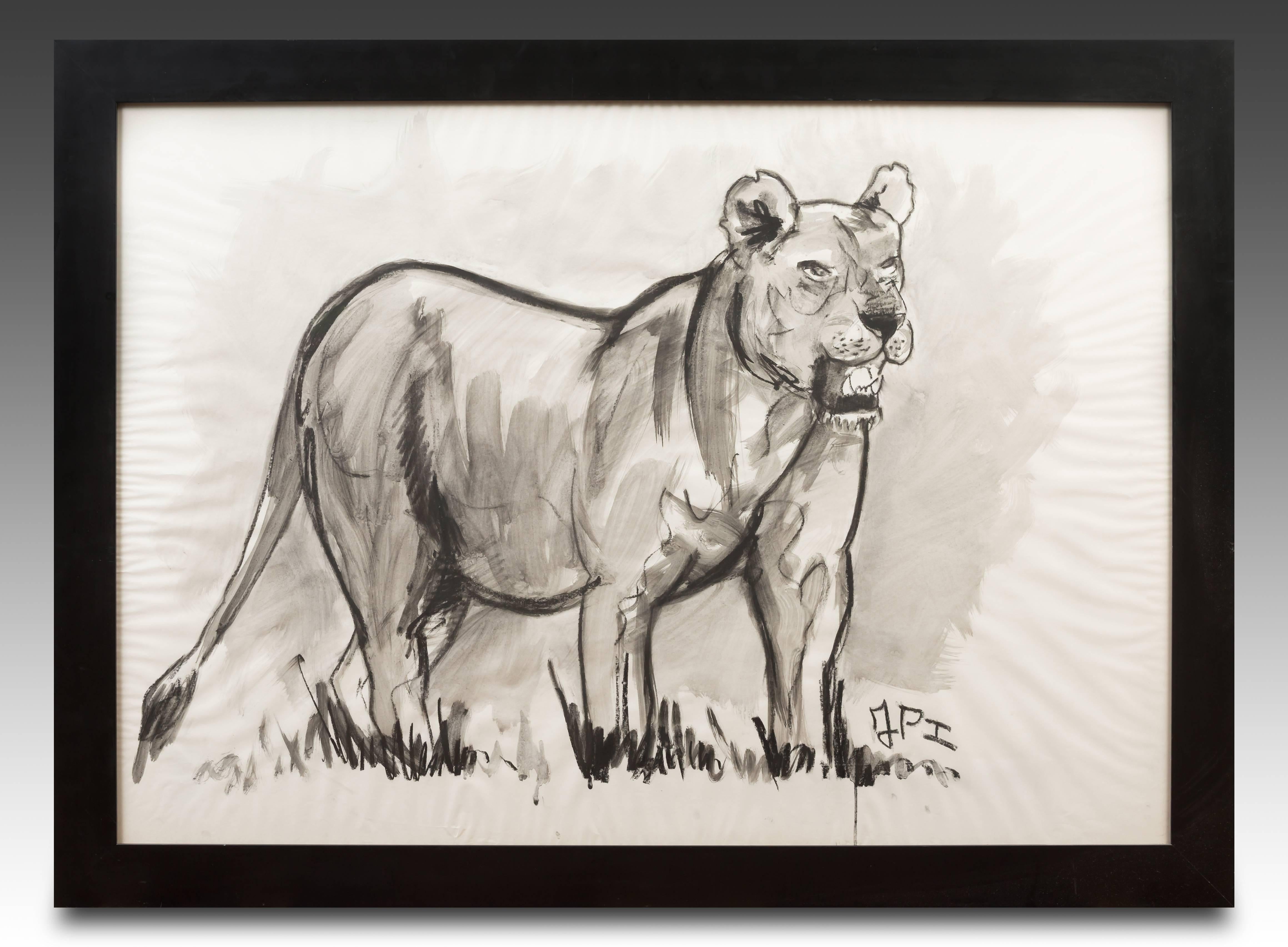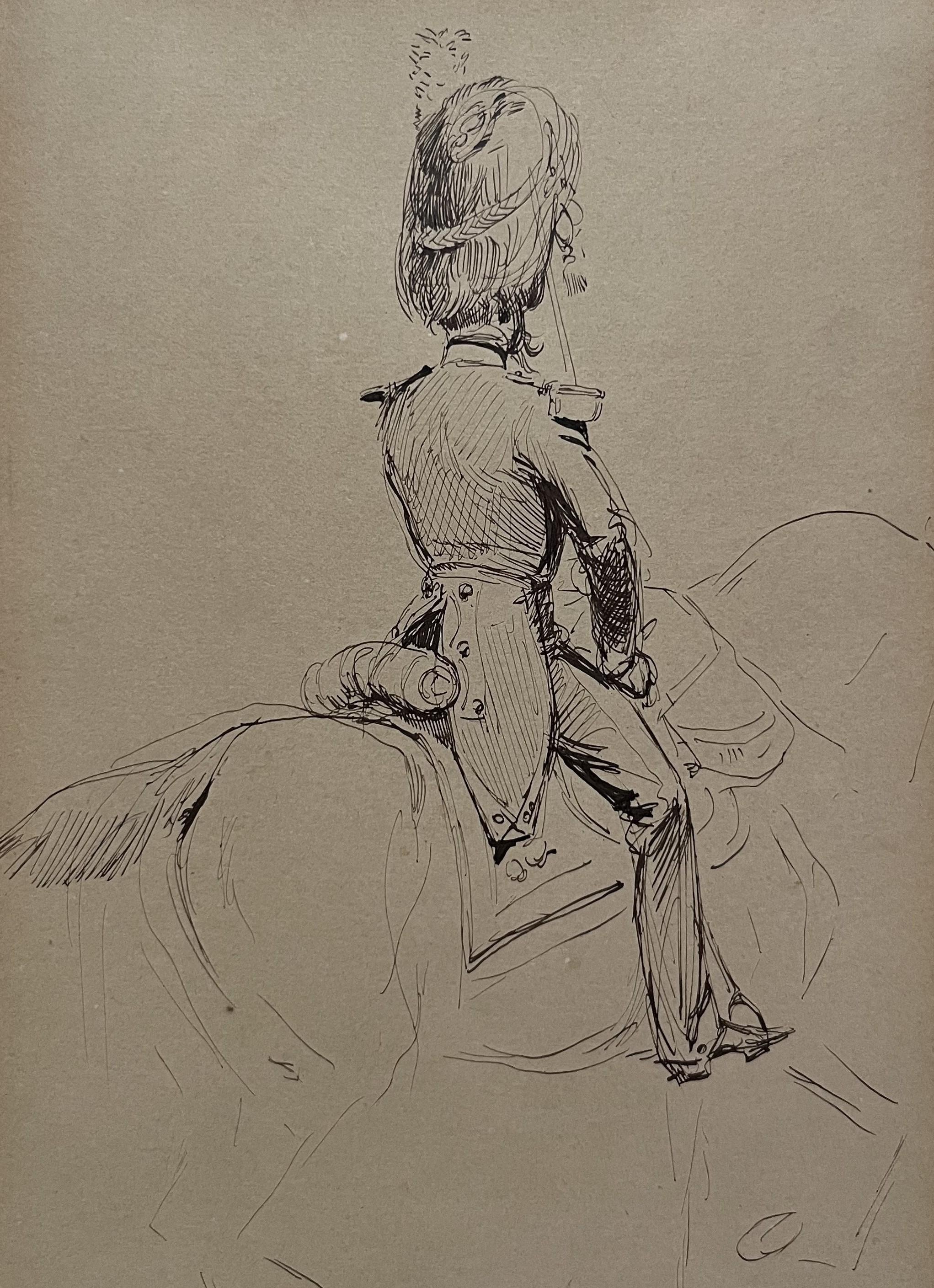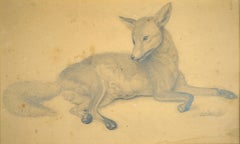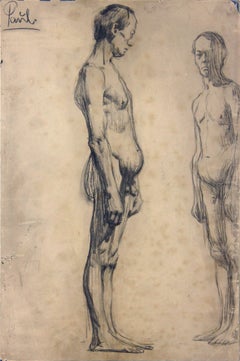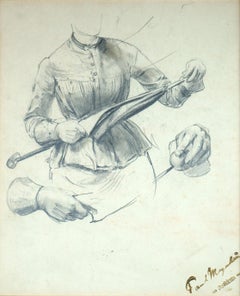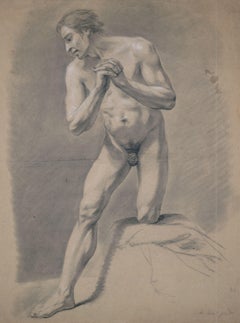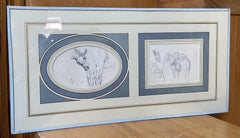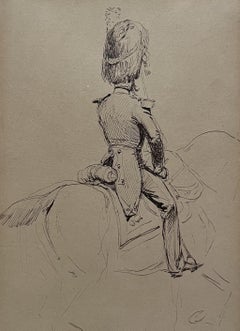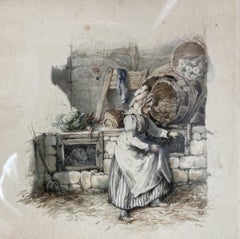Items Similar to Feeding the Kittens - Little cat mother -
Want more images or videos?
Request additional images or videos from the seller
1 of 8
Ernst Albert Fischer-CörlinFeeding the Kittens - Little cat mother -1893
1893
About the Item
Ernst Albert Fischer-Cörlin (1853 Körlin - 1932 Persante). Feeding the Kittens, 1893. Pencil on painting cardboard, 38 x 29 cm. Signed and dated by the artist at lower left "E[rnst] A[lbert] Fischer=Cörlin 1893".
- Lightly stained, somewhat dusty and minimally foxed.
- Little cat mother -
About the artwork
Daughter, mother and grandmother gather in the sunlight to feed a litter of kittens. The mother and grandmother hold the lively, playful animals in their arms, while the young girl feeds two of the four kittens with cookies. There is also a small bucket of milk and a bowl of milk. The women and the girl watch as the cute, still blind animals eat.
It is a scene taken from everyday life, but it also has an allegorical dimension, bringing maternal care into the representation. Three generations are represented, with the grandmother and the mother already mothers. They not only offer the kittens to the youngest, but also proudly observe the maternal care that the youngest gives to the kittens. Like the kittens, she will grow up and become a mother herself, so the image is also an allegory of life's ever-new beginnings. In keeping with this, the morning sun shines into the picture from the right. Fischer-Cörlin has masterfully worked out the quality of the light, with its light and dark areas, with the pencil used for hatching, which is particularly evident in the mother's face and the weave of her hat.
Although the half-timbered house in the background is uniquely laid out, it is not a sketch but a fully formulated pictorial idea and thus an independent work of art, signed and dated accordingly.
About the artist
Ernst Albert Fischer-Cörlin studied at the Berlin Academy of Arts under Eduard Daege and Julius Friedrich Anton Schrader. He then spent six years as a master student of Anton von Werner and was probably a member of Werner's staff for major commissions. After graduating from the academy, he worked as a freelance artist in Berlin.From 1877 to 1892 he participated in the exhibition of the Prussian Academy, from 1893 in the Great Berlin Art Exhibition, and also in the Great Dresden Art Exhibition. In addition, Fischer-Cörlin became a sought-after illustrator, whose pictures adorned several Stollwerck albums. He was also a virtuoso in the artistic design of baptismal certificates, diplomas and certificates of all kinds.
Selected Bibliography
Thieme-Becker. Allgemeines Lexikon der Bildenden Künstler von der Antike bis zur Gegenwart. Begründet von Ulrich Thieme und Felix Becker. Band 12: Fiori–Fyt, Leipzig 1916, S. 20.
Sauer. Allgemeines Künstlerlexikon. Die Bildenden Künstler aller Zeiten und Völker (AKL). Band 40, München u. a. 2004, S. 422.
GERMAN VERSION
Ernst Albert Fischer-Cörlin (1853 Körlin – 1932 Persante). Fütterung der Kätzchen, 1893. Bleistift auf Malkarton, 38 x 29 cm. Links unten eigenhändig signiert und datiert „E[rnst] A[lbert] Fischer=Cörlin 1893.“
- lichtrandig, etwas angestaubt und minimal stockfleckig
- Die kleine Katzenmutter -
zum Kunstwerk
Wohl Tochter, Mutter und Großmutter haben sich im Sonnenlicht versammelt, um einen Wurf Kätzchen zu füttern. Die Mutter und die Großmutter halten die quirlig verspielten Tiere auf den Armen, während das junge Mädchen zwei der vier Kätzchen mit Gebäck füttert. Zusätzlich steht ein kleiner Milcheimer und eine Schale Milch bereit. Die Frauen und das Mädchen betrachten die possierlichen, noch blinden Tiere bei der Nahrungsaufnahme.
Eine aus dem Alltag gegriffene Szenerie, die aber auch eine allegorische Dimension beinhaltet und die mütterliche Fürsorge zur Darstellung bringt. Es sind drei Generationen gezeigt, wobei die Großmutter und die Mutter bereits Mütter sind. Sie bieten der Jüngsten die Kätzchen nicht allein dar, sondern gewahren voll stolzer Aufmerksamkeit auch die mütterliche Fürsorge, welche die Kleinste den Kätzchen entgegenbringt. Wie die Kätzchen wird auch sie heranwachsen und selbst zur Mutter werden, so dass das Bild auch eine Allegorie auf das immer wieder neu beginnende Leben ist. Dazu passend scheint von rechts die Morgensonne ins Bild. Die Lichtqualität mit ihren hellen und dunklen Flächen hat Fischer-Cörlin meisterhaft mit dem schraffierend eingesetzten Bleistift herausgearbeitet, was sich besonders im Gesicht der Mutter und dem Geflecht ihres Hutes zeigt.
Obwohl das Fachwerkhaus im Hintergrund einzig angelegt ist, handelt es sich nicht um eine Skizze, sondern um eine ausformulierte Bildidee und damit um ein eigenständiges und dementsprechend signiertes und datiertes Kunstwerk.
zum Künstler
Ernst Albert Fischer-Cörlin studierte an der Berliner Akademie der Künste bei Eduard Daege und Julius Friedrich Anton Schrader. Anschließend war er sechs Jahre lang Meisterschüler bei Anton von Werner und gehörte – bei größeren Aufträgen – wohl auch zu Werners Mitarbeitern. Nach dem Abschluss der Akademie war er als freischaffender Künstler in Berlin tätig. Von 1877 bis 1892 nahm er an der Ausstellung der Preußischen Akademie, ab 1893 an der Großen Berliner Kunstausstellung teil und beschickte auch die Große Dresdener Kunstausstellung. Daneben wurde Fischer-Cörlin zum gefragten Illustrator, der unter anderem mehrere Stollwerck-Alben mit seinen Bildern ausstattete. Zudem war er ein Virtuose der künstlerischen Gestaltung von Taufbriefen, Diplomen und Urkunden jeglicher Art.
Auswahlbibliographie
Thieme-Becker. Allgemeines Lexikon der Bildenden Künstler von der Antike bis zur Gegenwart. Begründet von Ulrich Thieme und Felix Becker. Band 12: Fiori–Fyt, Leipzig 1916, S. 20.
Sauer. Allgemeines Künstlerlexikon. Die Bildenden Künstler aller Zeiten und Völker (AKL). Band 40, München u. a. 2004, S. 422.
- Creator:Ernst Albert Fischer-Cörlin (1853 - 1932)
- Creation Year:1893
- Dimensions:Height: 14.97 in (38 cm)Width: 11.42 in (29 cm)Depth: 0.4 in (1 cm)
- Medium:
- Movement & Style:
- Period:
- Condition:
- Gallery Location:Berlin, DE
- Reference Number:1stDibs: LU2438212340732

About the Seller
5.0
Gold Seller
Premium sellers maintaining a 4.3+ rating and 24-hour response times
Established in 2014
1stDibs seller since 2023
18 sales on 1stDibs
Typical response time: 6 hours
- ShippingRetrieving quote...Shipping from: Berlin, Germany
- Return Policy
Authenticity Guarantee
In the unlikely event there’s an issue with an item’s authenticity, contact us within 1 year for a full refund. DetailsMoney-Back Guarantee
If your item is not as described, is damaged in transit, or does not arrive, contact us within 7 days for a full refund. Details24-Hour Cancellation
You have a 24-hour grace period in which to reconsider your purchase, with no questions asked.Vetted Professional Sellers
Our world-class sellers must adhere to strict standards for service and quality, maintaining the integrity of our listings.Price-Match Guarantee
If you find that a seller listed the same item for a lower price elsewhere, we’ll match it.Trusted Global Delivery
Our best-in-class carrier network provides specialized shipping options worldwide, including custom delivery.More From This Seller
View AllVigilant Fox - The psyche of the fox -
Located in Berlin, DE
Carl Friedrich Deiker (1838 Wetzlar - 1892 Düsseldorf). Vigilant fox. Pencil drawing on brown paper, 18 × 29.5 cm (inside measurement), 31.5 x 43.5 cm (mount), signed and dated "Deiker [18]54" at lower right.
- a little bit stained, with a light water stain at lower right
About the artwork
Carl Friedrich Deiker's consummate ability to depict animals is already evident in this early work. He brought a whole new psychological dimension to animal painting, so that one could literally speak of animal portraits.
The naturalistic appearance of the fox alone makes it seem alive. Every strand of muscle, even every hair, is captured, which requires an intensive artistic study of animal anatomy and physiology. But the fox's real liveliness comes not from its natural appearance, but from its internal movement: Stretched out, it has been brought out of rest. It turns around and, with its ears pricked up, looks intently in the direction from which it has seen something. His mouth is slightly open and his pointed teeth are bared, as if he were growling. Tension gradually takes hold of his whole body. While the hind legs were still in a relaxed position, closely observed by Deiker, one front leg was already raised, ready to begin a rising movement. The fox seems so alarmed with all its senses that one gets the impression that, at any moment, its tail will move jerkily and the animal will jump up.
While wild animals have traditionally been portrayed as beasts or anthropomorphised, often for caricatural purposes, Deiker explores their inherent nature by attempting to capture their psychic impulses. The wild animal is neither bestial nor human, but a creature in its own right, valued by Deiker for its own sake. In this way, he brought the dignity of the animal into representation and raised animal painting to a whole new artistic level.
About the artist
Carl Friedrich Deiker was the son of the drawing teacher Christian Friedrich Deiker and the younger brother of the animal painter Johannes Deiker. In addition to the family art lessons, Christian Friedrich shared a studio with his brother Johannes at Braunfels Castle, Deiker attended the drawing academy in Hanau, and from 1858 he was a student at the Karlsruhe Art Academy, where he studied under the landscape painter Johann Wilhelm Schirmer. Carl Friedrich Deiker was already in demand as an artist during his first year: Grand Duke Frederick I of Baden, Margrave Max of Baden and Grand Duke Michael of Russia bought hunting scenes by him.
In 1859 he went on a study trip to the Reinhardswald. Just as the Barbizon School had rediscovered the landscape, Deiker opened up the forest for animal painting.
From 1861-64 Deiker had his own studio in Karlsruhe, then moved to Düsseldorf, where his brother Johannes followed four years later. Deiker married a daughter of the landscape painter Karl Hilger and remained in Düsseldorf until his death.
In 1868 he finally achieved international fame with his painting 'Pursued Noble Deer' and was regarded as a virtuoso new founder of animal painting.
"Deiker brought for the first time a truly great artistic quality to animal painting [...]".
- Hans Vollmer
From 1870 he participated in the academic art exhibitions in Berlin, Dresden, Munich and Hanover. He was also very busy as an illustrator. He drew for the Gartenlaube, the Salon, the Universum, and produced many of the finely illustrated hunting and animal books of the period. He also worked as a printmaker, while his oil paintings circulated as reprints by Franz Dinger.
From 1865 to 1892 Deiker was a member of the artists' association Malkasten.
Carl Friedrich Deiker's life's work was honoured with a large posthumous memorial exhibition at the Düsseldorf Kunsthalle in 1892.
His son Carl Deiker, born in 1879, also became a painter.
Selection of art museums that own works by Carl Friedrich Deiker:
Hamburger Kunsthalle / Kunsthalle Karlsruhe / Kunstmuseum Düsseldorf / Wallraff Richartz Cologne.
Selected Bibliography
H. Schmidt: Johannes and...
Category
1850s Naturalistic Animal Drawings and Watercolors
Materials
Pencil
$1,302 Sale Price
20% Off
Self-portrait - Homo nudus -
Located in Berlin, DE
Bruno Paul (1874 Seifhennersdorf - 1968 Berlin). Self-portrait, c. 1895. Pencil on paper, mounted on cardboard, 53.5 x 35 cm, signed 'Paul' at upper left.
- Homo nudus -
About the artwork
In a mirrored situation, Bruno Paul looks at himself in the picture. While his body, which is the size of the format, is shown in profile parallel to the picture, he turns his head into the picture in order to become aware of himself there, whereby the lighter use...
Category
1890s Realist Figurative Drawings and Watercolors
Materials
Pencil
$3,255 Sale Price
20% Off
Study with Torso, Hands, and Umbrella - The characteristic of the inconspicuous
Located in Berlin, DE
Paul Friedrich Meyerheim (1842 Berlin - 1915 ibid.). Sketch of a female torso with hands and an umbrella. Pencil on paper, 27.5 x 22.5 cm (visible size)...
Category
1890s Realist Figurative Drawings and Watercolors
Materials
Pencil
Male Nude / - The Drama of the Nude -
Located in Berlin, DE
Johann Heinrich Meil (1730 Gotha - 1820 Berlin), Male Nude, 1807. White heightened, occasionally wiped charcoal drawing on brownish paper, 51 cm x 39.5 cm, signed “J.[ohann] H.[einri...
Category
Early 19th Century Rococo Nude Drawings and Watercolors
Materials
Paper
Norwegian Pine Grove - The inner glow of the trees -
Located in Berlin, DE
Themistokles von Eckenbrecher (1842 Athens - 1921 Goslar), Norwegian pine grove, 1901. Watercolor on blue-green paper, 30 x 22 cm. Signed, dated and inscribed in his own hand "TvE. Fagermes [i.e. Fagermes]. 26.6.[19]01."
- Slight crease throughout at left margin, otherwise in good condition.
About the artwork
Themistokles von Eckenbrecher often traveled to Norway to study the nature that fascinated him there. On June 26, 1901, near the southern Norwegian town of Fagernes, in the summer evening sun, he saw a small pine grove, which he immediately captured in a watercolor. He exposed the trees growing on a small hill in front of the background, so that the pines completely define the picture and combine to form a tense motif. The tension comes from the contrast of form and color. The trunks, growing upward, form a vertical structure that is horizontally penetrated by the spreading branches and the pine needles, which are rendered as a plane. This structural tension is further intensified by the color contrast between the brown-reddish iridescent trunks and branches and the green-toned needlework.
Themistokles von Eckenbrecher, however, does not use the observed natural scene as an inspiring model for a dance of color and form that detaches itself from the motif and thus treads the path of abstracting modernism. Its inner vitality is to be brought to light and made aesthetically accessible through the work of art.
It is precisely in order to depict the inner vitality of nature that von Eckenbrecher chooses the technique of watercolor, in which the individual details, such as the needles, are not meticulously worked out, but rather a flowing movement is created that unites the contrasts. The trees seem to have formed the twisted trunks out of their own inner strength as they grew, creatingthose tense lineations that the artist has put into the picture. The inner strength continues in the branches and twigs, culminating in the upward growth of the needles. At the same time, the trunks, illuminated by the setting sun, seem to glow from within, adding an almost dramatic dimension to the growing movement.
Through the artwork, nature itself is revealed as art. In order to make nature visible as art in the work, von Eckenbrecher exposes the group of trees so that they are bounded from the outside by an all-encompassing contour line and merge into an areal unity that enters into a figure-ground relationship with the blue-greenish watercolor paper. The figure-ground relationship emphasizes the ornamental quality of the natural work of art, which further enforces the artwork character of the group of trees.
With the presentation of Themistokles von Eckenbrecher's artistic idea and its realization, it has become clear that the present watercolor is not a study of nature in the sense of a visual note by the artist, which might then be integrated into a larger work context, but a completely independent work of art. This is why von Eckenbrecher signed the watercolor. In addition, it is marked with a place and a date, which confirms that this work of nature presented itself to him in exactly this way at this place at this time. At the same time, the date and place make it clear that the natural work of art has been transferred into the sphere of art and thus removed from the time of the place of nature.
About the artist
Themistocles' parents instilled a life of travel in their son, who is said to have spoken eleven languages. His father, who was interested in ancient and oriental culture, was a doctor and had married Francesca Magdalena Danelon, an Italian, daughter of the British consul in Trieste. During a stay in Athens - Gustav von Eckenbrecher was a friend of Heinrich von Schliemann and is said to have given him crucial clues as to the location of Troy - Themistokles saw the light of day in 1842.
After an interlude in Berlin, where Themistokles was educated at the English-American School, the journey began again. From 1850 to 1857 the family lived in Constantinople, after which the father opened a practice in Potsdam, where Themistokles, who wanted to become a painter, was taught by the court painter Carl Gustav Wegener.
In 1861 the von Eckenbrechers left Potsdam and settled in Düsseldorf. There Themistokles received two years of private tuition from Oswald Aschenbach, who greatly admired the talented young artist. After his artistic training, he undertook extensive travels, often accompanied by Prince Peter zu Sayn-Wittgenstein, which took him to northern and eastern Europe, but above all to the Middle East and even to South America. The paintings that resulted from these journeys established his artistic reputation and led to his participation in large panoramas such as the 118 x 15 metre Entry of the Mecca Caravan into Cairo, painted for the City of Hamburg in 1882.
1882 was also the start of a total of 21 study trips to Scandinavia, most of them to Norway, and the unique Norwegian landscape with its rugged fjords became a central motif in his work. Along with Anders Askevold and Adelsteen Normann...
Category
Early 1900s Naturalistic Landscape Drawings and Watercolors
Materials
Watercolor
$1,116 Sale Price
20% Off
Half-length portrait of a Pharisee - In the shadow of betrayal -
Located in Berlin, DE
Hermann Prell (1854 Leipzig - 1922 Dresden-Loschwitz). Half-length portrait of a Pharisee, 1885. Sketch for the right-hand figure in the painting Judas Iscariot, 1886. Pencil drawing heightened with opaque white and black chalk on beige-grey wove paper (papier vélin), 34 x 27.8 cm (visible size), 52 x 45 cm (mount), signed, dated and inscribed "H. PRELL 1885 zu 'Judas'".
Minor browning, collection stamp on the reverse.
- In the shadow of betrayal -
About the artwork
This painting is the sketch for the head of the Pharisee offering the coins to Judas in one of Herrmann Prell's major works, the painting Betrayal of Judas, completed in 1886. The painting belongs to the Staatliche Kunstsammlungen Dresden and is illustrated in Adolf Rosenberg: Prell, Bielefeld and Leipzig 1901, p. 21 (Fig. 19). It is especially highlighted in Thieme-Becker (vol. 27, p. 376).
Hermann Prell, Betrayal of Judas, 1886
The monumental head, which fills the picture and is distinguished by its ornamented robe, is almost a lost profile, which in the executed painting is justified by the Pharisee's turning towards Judas. Despite the fact that the sitter withdraws from the viewer by turning away, it was necessary to artistically elaborate the motivation for the purchase of one of Christ's disciples, which is why the drawing focuses on the expression of the face, while the 'accessories' are treated in a more summary manner.
In characterising the face, Hermann Prell performs a balancing act: since the Pharisee, despite his destructive actions, is an actor in the history of salvation, the head must show a dignity appropriate to the event, but at the same time the physiognomy must also bear witness to the scheming attitude that led to the betrayal. To solve this dilemma, Prell draws on the traditional depictions of the heads of the apostles, shading the face to indicate the obdurate darkness of the spirit and moving the base of the nose slightly upwards while the mouth falls away, thus giving a physiognomic expression to the motivation of the action. The fatal drama of the betrayal is expressed in the monumentalisation of the head and in the thunderous white highlights that contrast with the darkness of the chalk.
As a study, considered by the artist to be a work in itself, this drawing reveals the pictorial problems and brainstorming of monumental painting.
About the artist
In 1872 Prell, who was one of the most important exponents of monumental painting of his time, began studying painting with Theodor Grosse at the Dresden Academy of Art and continued with Carl Gussow at the Berlin Academy in 1876. Hans von Marées taught him in Rome in 1878. More influential on his work, however, were Arnold Böcklin and Max Klinger, with whom Prell had been friends since his student days and with whom he worked together on several occasions.
Prell's first major work, which established his reputation as a monumental painter, were the frescoes in the banqueting hall of the Architektenhaus in Berlin in 1881/82, commissioned by the state and depicting the different periods of architecture. Prell then went to Italy for two years to study fresco painting. Other major commissions followed. These included monumental frescoes in the town halls of Worms (1884), Hildesheim (1882-92), Gdansk (1895) and Dresden, the staircase of the Silesian Museum of Fine Arts in Breslau (1893/94), the throne room of the German Embassy in Rome (1896-99) and the staircase of the Albertinum in Dresden (1900-1904).
From 1886 Prell taught at the academy of arts in Berlin and in 1892 he was appointed professor at the academy of arts in Dresden. His students included Osmar Schindler and Hans Unger...
Category
1880s Realist Figurative Drawings and Watercolors
Materials
Chalk
$1,395 Sale Price
20% Off
You May Also Like
Pair of Kate Greenaway original watercolour artworks 'Under the Window', 1879
Located in Petworth, West Sussex
Kate Greenaway (British, 1846 – 1901)
‘Prince Finikin and his Mamma sat sipping their bohea..’; and ‘You see, merry Phyllis, that dear little maid, Has invited Belinda to tea..’
Penc...
Category
19th Century Academic Figurative Drawings and Watercolors
Materials
Watercolor, Pencil
French School 19th Century, Studies of horses, two drawings
Located in Paris, FR
French School 19th Century,
Studies of horses,
two drawings in the same frame
7 x 11 cm (oval) and 7 x 9.8 cm
pencil on paper
Condition : The oval one on the left with foxings (see...
Category
1880s Academic Animal Drawings and Watercolors
Materials
Pencil
$199 Sale Price
30% Off
Edouard Detaille (1848 1912) An officer of the Gendarmerie Impériale, drawing
By Jean Baptiste Édouard Detaille
Located in Paris, FR
Edouard Detaille (1848-1912)
An officer of the Gendarmerie Impériale, viewed of the back
bears the monogram ED but it is not visible because it is hidden by the mounting of the frame...
Category
1880s Academic Figurative Drawings and Watercolors
Materials
Ink
Attributed to Eugène Lami (1800-1890) A Maid feeding rabbits, Watercolor
By Eugène Louis Lami
Located in Paris, FR
Attributed to Eugène Lami (1800-1890)
A maid feeding rabbits
Watercolor on paper
Bears a monogramm E L on the lower right
12.5 x 12.5 cm
In good condition, some foxings in the uppe...
Category
1860s Academic Figurative Drawings and Watercolors
Materials
Watercolor
Antilopes, Drawing by Jean Poulain, Framed
By Jean Poulain
Located in Pasadena, CA
Jean Poulain 1884-1967
Jean Poulain was born in 1884 in Katanga (formerly Belgian Congo). The self-taught artist from an early age, he will be in search of all the emotions and beau...
Category
1940s Naturalistic Figurative Drawings and Watercolors
Materials
Carbon Pencil
$1,600 Sale Price
20% Off
Lioness in the Savannah by Jean Poulain
By Jean Poulain
Located in Pasadena, CA
Jean Poulain 1884-1967
Jean Poulain was born in 1884 in Katanga (formerly Belgian Congo). The self-taught artist from an early age, he will be in search of all the emotions and beau...
Category
1940s Other Art Style Figurative Drawings and Watercolors
Materials
Carbon Pencil
$2,000 Sale Price
20% Off
Recently Viewed
View AllMore Ways To Browse
The Artist Mother
Mother Daughter Art
Young Mother
Antique Cat
Antique Cat Art
Mother Daughter Paintings
Dresden Art
Mother And Daughter Painting
German Cat
Albert Young
Cat Watercolor Painting
Watercolour Painting Of Cat
Girl And Cat
Pencil Animal Sketches
Kitten Paintings
Painting Of Kittens
Girl Cat Painting
Antique Hut
